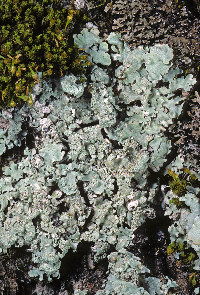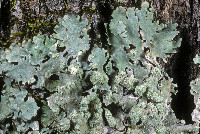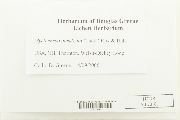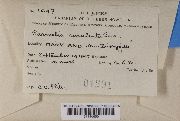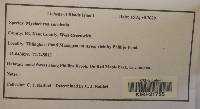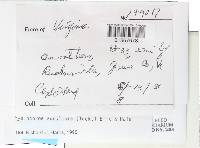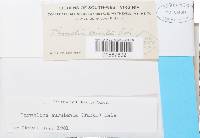
Consortium of Lichen Herbaria
- building a Global Consortium of Bryophytes and Lichens as keystones of cryptobiotic communities -
- Home
- Search
- Images
- Species Checklists
- US States: O-Z >
- US National Parks
- Central America
- South America
- US National Parks
- Southern Subpolar Region
|
|
|
|
Family: Parmeliaceae
Powdery Axil-bristle Lichen
[Hypotrachyna aurulenta (Tuck.) Krog & Swinscow, moreParmelia aurulenta Tuck., Parmelia aurulenta var. aurulenta Tuck., Parmelia aurulenta var. silvestris (Degel.) Degel., Parmelia silvestris Degel., Parmelina aurulenta (Tuck.) Hale] |
Nash, T.H., Ryan, B.D., Gries, C., Bungartz, F., (eds.) 2002. Lichen Flora of the Greater Sonoran Desert Region. Vol 1. Thallus: foliose, moderately to loosely adnate, ± circular, 4-10 cm broad, subdichotomously to irregularly lobate lobes: sublinear to subirregular, 2-4 mm wide, sinuous in the axils, contiguous to somewhat imbricate; apices: subrotund; margin: entire or crenulate, ciliate; cilia: short, up to 0.8 mm, mostly in lobe axils upper surface: pale green to bluish gray (whitish gray in herbarium), shiny, smooth to rugulose centrally, sorediate soredia: farinose to granular, arising from coarse pustules or soralia that become broad and diffuse; isidia: absent medulla: white to pale yellow, yellow-orange under the soralia; algal layer continuous lower surface: black with a brown zone (1-5 mm wide) peripherally, smooth to rugulose, densely rhizinate; rhizines: simple to furcate, or squarrosely branched Apothecia: rare, sessile to subpedicellate, 2-5 mm diam. ascospores: poorly developed, 10-12 x 5-7 µm Pycnidia: rare, immersed conidia: bifusiform, 5-6 x 1 µm Spot tests: cortex: K+ yellow, C-, KC-, P-; medulla: K-, C-, KC-, P- or pigmented area turning darker yellow in K Secondary metabolites: upper cortex with atranorin and chloroatranorin and secalonic acid A; medulla with zeorin, leucotylic acid, and, where pigmented, secalonic acid A. Substrate and ecology: on trees and rocks, in woodlots and along roads in open habitats World distribution: pantropical, eastern North America and Japan Sonoran distribution: rare in the mountains of SE Arizona and extending southwards along the Sierra Madre Occidental in Chihuahua. |
|
|
|
Powered by Symbiota




